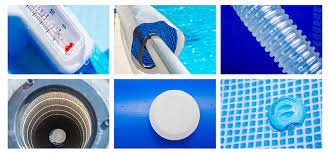
Pool Startup Procedure
The following procedure should be used whenever a pool is being filled for the first time, refilled following maintenance or other major repair or when restarting the pool for the swimming season.
- Before first filling a pool or adding substantial amounts of fresh water to the pool, either test the water using a good quality test kit or have it tested for pH, total alkalinity, calcium hardness and stain producing metals. This will tell you what type of treatment will likely be required once the pool is full and allow treatment measures to be taken that will prevent problems from the water source.
- In cases where the pool is being reopened and was covered all winter, remove the cover carefully so as to avoid having any leaves or other debris fall into the pool. Sweep up and remove as much material as possible that may have accumulated in the pool during the off season.
- In cases where the pool is being completely filled be certain to add a good sequestering agent as soon as the filling process begins. If the pool is already full, add the sequestering agent before any other steps are followed. This will tie up and inactivate any stain-producing metals that may be in the fill or pool water. This should be done even if the water analysis did not show the presence of these metals in the water sample. Note: If the pool construction happens to be black plaster, the sequestering agent should not be added until the pool is completely full.
- Add a clarifier to the water. The clarifier will help the filter remove the very tiny particles that enter the pool in the filling process or that may remain following construction and installation.
- Start the pump and filtration equipment and allow the water to circulate for 24 hours, if practical. This will assure that the sequestering agent and clarifier have been completely mixed in the water thus avoiding stain formation, cloudy or colored water.
- Shock / oxidize the pool using a quality non-chlorine shock oxidizer. This will destroy organic wastes in the water and keep them from interfering with the sanitizer or acting as a food source for algae. It will also help give the water a “polished” look.
- Again test the water and adjust if needed to balance the water. pH should be in the range of 7.2-7.8, total alkalinity between 80-120 ppm and calcium hardness between 100 and 400 ppm.
- Begin to add your desired sanitizer to the water following the manufacturer’s guidelines.
- If using chlorine in an outdoor pool, stabilizer (cyanuric acid or stabilized trichlor tabs) should be added to help the chlorine last longer and work more economically. Consult label directions.
- Add an algaecide. The algaecide will prevent any algae in the pool from growing even if the sanitizer used were to fail. The regular use of an algaecide will keep the pool looking clean and bright and help the sanitizer to work more efficiently.
- Test the sanitizer residual and maintain at the recommended level.
- The pool is now ready for use.